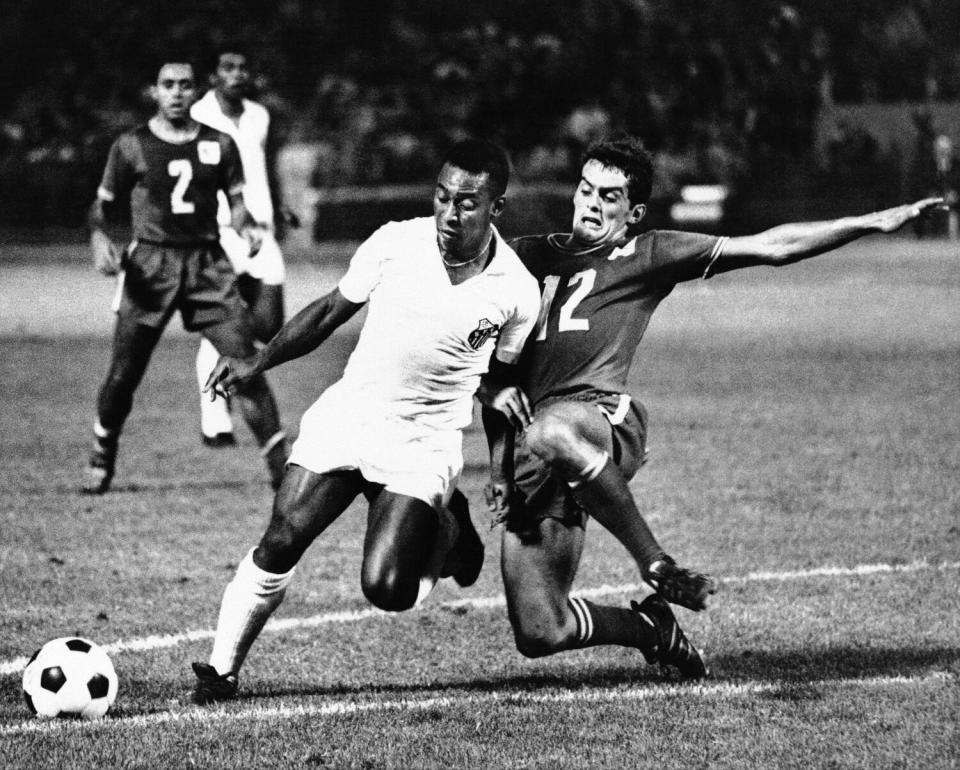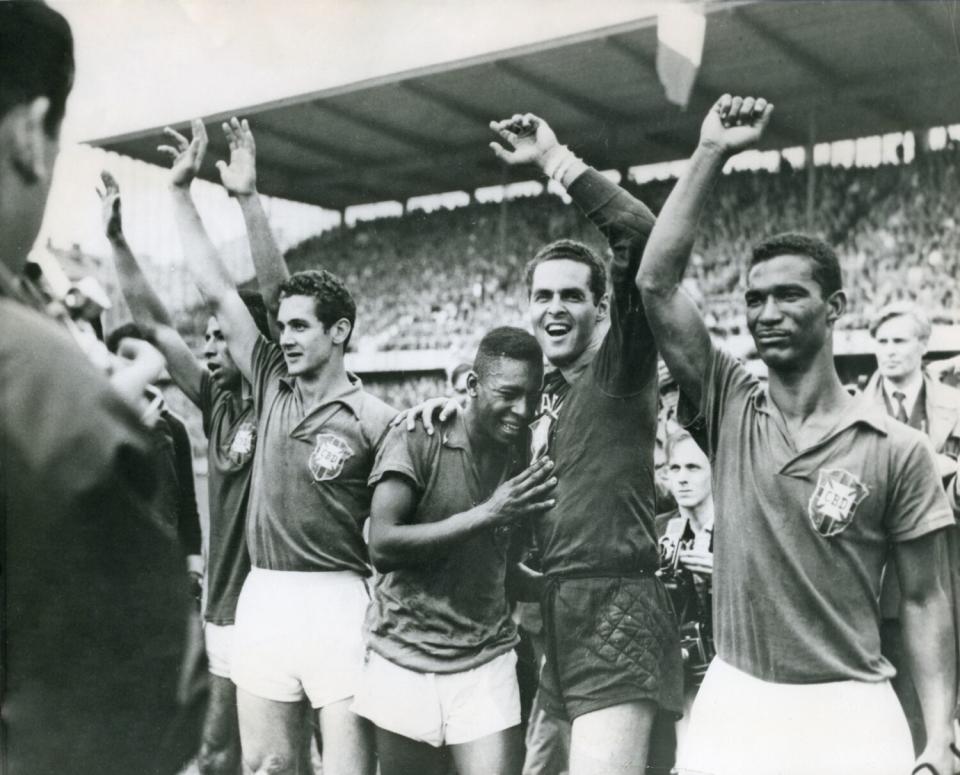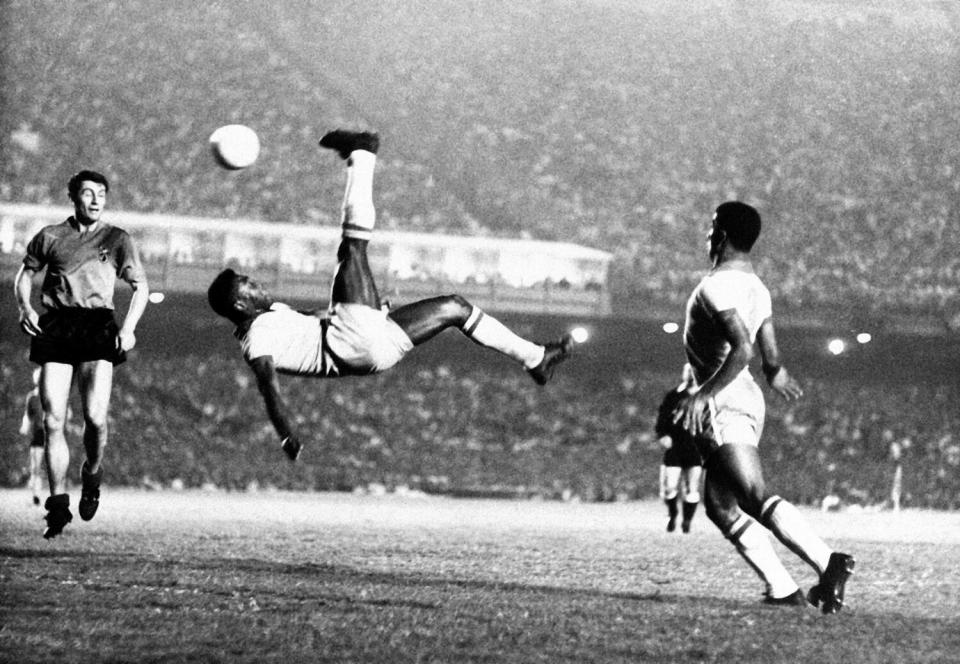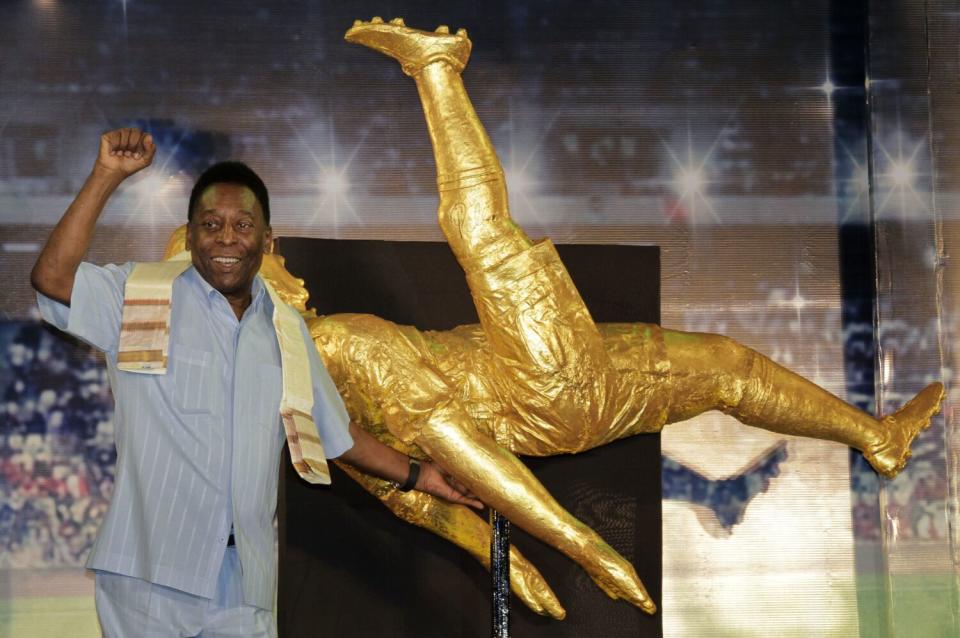Pelé, who rose from a Brazilian slum to become the world's greatest soccer player, dies at 82

Growing up in Brazil, Edson Arantes do Nascimento so hated the nonsensical nickname his grade school playmates used to tease him that he would fight anyone who dared call him “Pelé.”
Before he had become an adult, however, the boy had turned the taunt into a word that came to define soccer greatness, embarking on a career that would produce more goals, more World Cup titles and more breathtaking moments than any other.
“People said, ‘Pelé! Pelé! Pelé!’ all over the world,” the boy once lamented long after he had become a man. “But no one remembers Edson. Edson is the person who has the feelings, who has the family, who works hard. Pelé is the idol.”
The soccer player who rose from an impoverished slum to become the most famous — and, for a time, the best-paid — athlete in the world died Thursday at age 82. Never far from the game he so loved, Pelé succumbed to multiple organ failure as a result of colon cancer, according to the São Paulo medical center where he had been hospitalized since late November.
“All that we are is thanks to you,“ his daughter Kely Nascimento wrote on Instagram. “We love you endlessly. Rest in peace.“
His agent, Joe Fraga, confirmed his death: “The king has passed.”
With his sharp passing, daring runs and blistering shots on goal, which he could take with either foot, Pelé utterly transformed soccer during a 21-year career in which he scored an unprecedented 1,281 goals, although more than 500 of those came in "unofficial" matches on barnstorming tours popular during his early playing days. As a result, Portugal's Cristiano Ronaldo's 819 goals are considered the all-time record, ahead of Pelé's 757.
But numbers alone couldn't define Pelé’s magic, which was so special that armies on both sides of a bloody civil war in Nigeria agreed to a two-day truce so that soldiers could watch him play. The shah of Iran once waited three hours at an airport just to speak with him, the Secret Service let him bounce a ball off President Ford’s head, and a survey in the waning days of his playing career showed that Coca-Cola was the only brand more popular than Pelé in Europe.
“Pelé is the greatest player in football history,” Ronaldo said. “And there will only be one Pelé.”
“Pelé,” said the late Dutch star Johan Cruyff, a legend in his own right, “was the only footballer who surpassed the boundaries of logic.”
Pelé wasted little time building his legacy, scoring in his debut with the Brazilian national team to become, at 16 years and 9 months, the youngest player in history to score an international goal. Two years later he would become the youngest man to play — and score — in a World Cup.

But it was the elegance and joy with which he played that gave birth to the Brazilian style known as jogo bonito, or the beautiful game, which relies on speed, improvisation and creativity more than brute strength.
“His great secret was improvisation,” said Tostão, a former World Cup teammate. “Those things he did were in one moment. He had an extraordinary perception of the game. Pelé was the greatest. He was simply flawless.”
Edson Arantes do Nascimento was born on Oct. 23, 1940 — his birth certificate reads Oct. 21, a date Pelé insisted was incorrect — in the southern Brazilian state of Minas Gerais, his name inspired by the inventor Thomas Edison.
He was known as Dico by his family, but the neighborhood kids called him Pelé, mimicking his mispronunciation of the name of his favorite player, a Brazilian goalkeeper known as Bile. In time the taunt would become the most famous name in sports.
He was the eldest of three children born to Celeste Arantes and Joao Ramos do Nascimento, a minor league soccer player whose career was cut short by a knee injury. Nevertheless, he would leave an indelible mark on soccer by teaching the game to his son, who would be declared a national treasure by Brazil’s president before he had turned 21 and be voted international soccer’s player of the century and the International Olympic Committee’s athlete of the century more than 20 years after he retired.

The family, which included an uncle and grandmother, was poor and lived in a two-room house made of salvaged brick and washed plaster and with a roof that leaked. The children wore secondhand clothes, often went without shoes and sometimes had no more to eat than one daily meal of bread and a slice of banana.
The family’s situation improved only slightly when it moved to the crossroads city of Bauru, about 180 miles west of São Paulo. But in the fourth grade Pele quit his studies after being expelled for playing soccer during the school day. He soon took a job repairing shoes for $2 a day to help his family.
Because he couldn’t afford a soccer ball, he learned to play on the streets using grapefruits or cloth stuffed with newspapers and bound with string.
“The leather ball was very expensive,” Pelé told The Times in a 2014 interview. “We used to get my father’s old socks, my mother’s, then we’d fill them up with paper and play.”
His first memory of soccer’s vital place in Brazilian culture came in 1950 when the national team, heavily favored to win the World Cup final in Rio de Janeiro, was upset by Uruguay. At the final whistle one fan died by suicide and three others suffered fatal heart attacks.
Pelé’s father, who had followed the game on radio, burst into tears.
“It was the first time I saw my father cry,” Pelé remembered years later. “Then I made a joke and told him, ‘Don’t cry, don’t cry. I’m going to win the World Cup for you.’"
Eight years later the joke became a prophecy when a 17-year-old Pelé scored six goals — including two in the final game — to carry Brazil to the first of its record five World Cup triumphs. Pelé was also part of championship teams in 1962 and 1970, making him the only person in history to win three World Cups.
“I told myself before the game: He's made of skin and bones just like everyone else,” said Italian defender Tarcisio Burgnich, who had the unenviable task of marking Pelé in the 1970 final. “But I was wrong.”
The boast to his father wasn’t the only one Pelé’s talent made good on. When he was only 15, his youth-team coach urged the directors of the formidable Brazilian club Santos to sign Pelé, insisting he would soon be “the greatest football player in the world.”

The directors listened and over the next 18 years Pele led the team to six national championships and victories in six international tournaments before his retirement at 33. Pele earned nearly $1 million in his final season in Brazil in 1974 — the equivalent of more than $6.3 million today — and donated it all to children’s charities.
But a series of bad investments left him near financial ruin a couple of years later, so Pelé returned to soccer, signing a three-year, $4.5-million contract with the New York Cosmos of the struggling North American Soccer League. He went on to score 31 goals and win another league title while captivating even the most jaded U.S. sports fans.
A then-record 10 million TV viewers watched the live broadcast of his 1975 Cosmos debut. With Pelé, the league’s average attendance jumped nearly 80%, driving the Cosmos out of tiny Downing Stadium on Randall's Island to Yankee Stadium, where they often played before larger crowds than the baseball team.
By the end of Pelé’s final season in 1977, the team had moved to Giants Stadium, where it drew 77,691 for a playoff game, at the time the largest crowd to attend a soccer match in the United States.
He played his final official game — and scored his final goal — later that year, playing one half for the Cosmos and one half for Santos at Giants Stadium on a day that was so bittersweet that a Brazilian newspaper, noting the rainy conditions, said “even the sky was crying.”
After Pelé left, the crowds evaporated, falling to an average of less than 13,000 by the time the NASL folded in 1984. But the legacy he left behind was credited by many with paving the way for the U.S. to play host to the 1994 World Cup, still the most financially successful and best-attended soccer tournament in history.

If retirement kept Pelé off the field, save for occasional charity matches and exhibitions, it didn’t keep him away from soccer or out of the public eye. Nor could his celebrity be confined to one country or even one genre.
He was the personal guest of at least three popes, six emperors, eight presidents, 15 kings and more than four dozen other heads of state. He was a United Nations ambassador for ecology and the environment, a UNESCO goodwill ambassador, and in his role as Brazil's minister of sports he proposed legislation to reduce corruption in soccer, a bill that became known as “Pelé’s Law.”
He wrote several autobiographies, acted in at least a dozen films and a TV series, composed the soundtrack for the 1977 film “Pelé” and was honored with knighthood in England, a postage stamp in North Korea and in the song “Ghetto Supastar” by the American rapper Pras.
There seemed to be nothing he couldn’t do and no product he wouldn’t pitch while also spending time as a broadcaster and sports columnist. Even in his 70s, Pelé kept up a punishing promotional schedule, often visiting three or four continents a week. Estimates of his annual earnings approached $30 million.
Asked during his travels if his fame compared to that of Jesus Christ, Pelé answered with characteristic hubris and humor, saying “there are parts of the world where Jesus Christ is not so well known.”
But there were controversies as well.
Pelé long denied claims made by a woman who said she was his daughter. Sandra Arantes do Nascimento eventually sued him, and a Brazilian court backed her claim, citing DNA evidence.
The case caused a national scandal, and she would go on to write an autobiography, “The Daughter the King Didn’t Want,” before winning a seat on the Santos City Council. She died of breast cancer in 2006 at 42.

Pelé, who married twice, had five other children, two from his first marriage, two from his second and another from an extramarital affair.
Pelé’s reputation was also rocked by allegations that his management company stole $700,000 it accepted from UNICEF to fund a 1995 charity soccer game that was never played. Pelé responded by shutting down Pele Sports & Marketing and suing longtime business partner Helio Viana, who he claimed had siphoned off up to $10 million over two decades.
One of Pelé’s greatest nonplaying moments was supposed to come in 2014, when the World Cup returned to Brazil for the first time since the 1950 upset that had reduced his father to tears. But that too ended in controversy.
Although his face was omnipresent on billboards and in TV commercials, and a $22-million museum dedicated to his career opened in Santos during the monthlong tournament, Pelé the man was virtually invisible during the World Cup, his absence apparently stemming from a spectacular misreading of the national mood in Brazil.
When millions took to the streets to protest the cost of staging the World Cup, Pelé released an awkward YouTube clip in which he urged people to forget the commotion and support the national team.
Realizing his mistake, Pelé quickly reversed course and accused officials of stealing, which angered tournament organizers. Then, days before the tournament began, his son Edson Cholbi do Nascimento, a former Santos goalkeeper and coach known as Edinho, was found guilty of laundering money obtained through drug trafficking and sentenced to 33 years in prison.
Yet for all his personal troubles, those who saw him play insist Pelé was flawless.
“Pelé is the greatest player of all time,” said German World Cup winner Franz Beckenbauer. “All the others — Diego Maradona, Johan Cruyff, Michel Platini — rank beneath him. There’s no one to compare with Pele.”
Few understood Pelé’s uniqueness more than Edson Arantes do Nascimento, who frequently credited good timing and good genes for the transformative career of the man known simply as Pelé. Asked whether there would ever be another player to match his brilliance and dominance, he shook his head and again credited his parents.
“Better than me? No,” he said with a chuckle. “You know why? Because my mother and my father closed the machine.”
The Associated Press contributed to this report.
This story originally appeared in Los Angeles Times.

